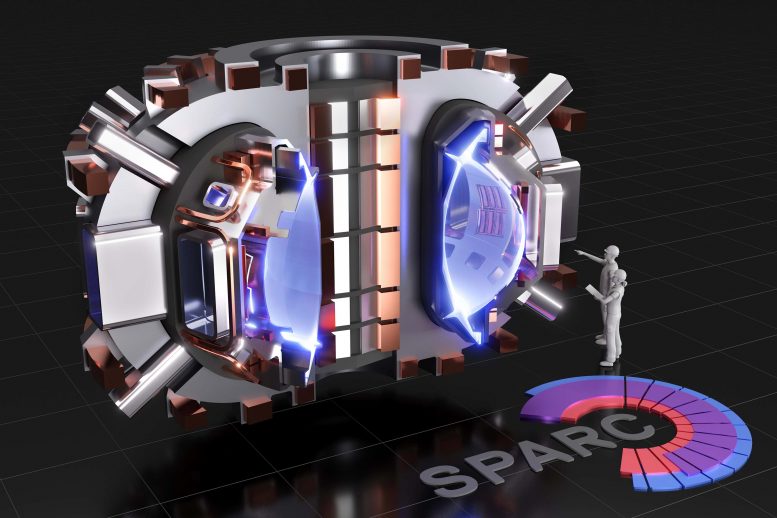
A new AI tool is giving fusion research a huge boost by spotting hidden “safe zones” inside reactors where parts are shielded from scorching plasma heat.
Called HEAT-ML, the system can do in milliseconds what once took half an hour, allowing scientists to design reactors faster and more safely. Tested on the SPARC fusion reactor, which aims to produce more energy than it consumes by 2027, the AI could accelerate the race toward practical clean fusion power.
Breakthrough AI Speeds Fusion Research
A collaboration between Commonwealth Fusion Systems (CFS), the U.S. Department of Energy’s (DOE) Princeton Plasma Physics Laboratory (PPPL), and Oak Ridge National Laboratory has produced a new artificial intelligence (AI) method that can quickly detect “magnetic shadows” inside a fusion device. These shadows are areas shielded from the searing plasma, acting as safe zones for reactor components.
The system, called HEAT-ML, could become the basis for software that dramatically accelerates the design of future fusion machines. It may also assist during reactor operation by making rapid adjustments to the plasma, preventing potential problems before they develop.
“This research shows that you can take an existing code and create an AI surrogate that will speed up your ability to get useful answers, and it opens up interesting avenues in terms of control and scenario planning,” said Michael Churchill, co-author of a paper in Fusion Engineering and Design about HEAT-ML and head of digital engineering at PPPL.
The Promise and Challenge of Fusion Power
Fusion, the same reaction that powers the sun and stars, has the potential to deliver nearly unlimited electricity here on Earth. To reach that goal, scientists must first overcome major scientific and engineering hurdles. A central challenge is managing the extreme heat produced by plasma, which can burn hotter than the core of the sun when confined inside a magnetic vessel known as a tokamak. Calculations that predict where this heat will land, and which areas will remain shielded in magnetic shadows, are crucial to making fusion energy practical.
“The plasma-facing components of the tokamak might come in contact with the plasma, which is very hot and can melt or damage these elements,” said Doménica Corona Rivera, an associate research physicist at PPPL and first author on the paper on HEAT-ML. “The worst thing that can happen is that you would have to stop operations.”

A Targeted Approach for SPARC’s Toughest Test
HEAT-ML was specifically made to simulate a small part of SPARC: a tokamak currently under construction by CFS. The Massachusetts company hopes to demonstrate net energy gain by 2027, meaning SPARC would generate more energy than it consumes.
Simulating how heat impacts SPARC’s interior is central to this goal and a big computing challenge. To break down the challenge into something manageable, the team focused on a section of SPARC where the most intense plasma heat exhaust intersects with the material wall. This particular part of the tokamak, representing 15 tiles near the bottom of the machine, is the part of the machine’s exhaust system that will be subjected to the most heat.
To create such a simulation, researchers generate what they call shadow masks. Shadow masks are 3D maps of magnetic shadows, which are specific areas on the surfaces of a fusion system’s internal components that are shielded from direct heat. The location of these shadows depends on the shape of the parts inside the tokamak and how they interact with the magnetic field lines that confine the plasma.
From HEAT to HEAT-ML
Originally, an open-source computer program called HEAT, or the Heat flux Engineering Analysis Toolkit, calculated these shadow masks. HEAT was created by CFS Manager Tom Looby during his doctoral work with Matt Reinke, now leader of the SPARC Diagnostic Team, and was first applied on the exhaust system for PPPL’s National Spherical Torus Experiment-Upgrade machine.
HEAT-ML traces magnetic field lines from the surface of a component to see if the line intersects other internal parts of the tokamak. If it does, that region is marked as “shadowed.” However, tracing these lines and finding where they intersect the detailed 3D machine geometry was a significant bottleneck in the process. It could take around 30 minutes for a single simulation and even longer for some complex geometries.
HEAT-ML overcomes this bottleneck, accelerating the calculations to a few milliseconds. It uses a deep neural network: a type of AI that has hidden layers of mathematical operations and parameters that it applies to the data to learn how to do a specific task by looking for patterns. HEAT-ML’s deep neural network was trained using a database of approximately 1,000 SPARC simulations from HEAT to learn how to calculate shadow masks.
Expanding to a Universal Fusion Tool
HEAT-ML is currently tied to the specific design of SPARC’s exhaust system; it only works for that small part of that particular tokamak and is an optional setting in the HEAT code. However, the research team hopes to expand its capabilities to generalize the calculation of shadow masks for exhaust systems of any shape and size, as well as the rest of the plasma-facing components inside a tokamak.
Reference: “Shadow masks predictions in SPARC tokamak plasma-facing components using HEAT code and machine learning methods” by D. Corona, M. Scotto d’Abusco, M. Churchill, S. Munaretto, A. Kleiner, A. Wingen and T. Looby, 2 May 2025, Fusion Engineering and Design.
DOI: 10.1016/j.fusengdes.2025.115010
PPPL researchers Manuel Scotto d’Abusco and Stefano Munaretto also worked on this research which was supported under DOE contracts DE-AC02-09CH11466 and DE-AC05-00OR22725, and it also received support from CFS.
Never miss a breakthrough: Join the SciTechDaily newsletter.
1 Comment
AI That Finds “Shadows” in Fusion Reactors Could Unlock Clean Energy Faster.
VERY GOOD.
Based on the Topological Vortex Theory (TVT), human intelligence and civilization shall can not be the sole embodiment of sentient forms in the material world ( https://zhuanlan.zhihu.com/p/1938229158724498993 ).
An entire generation has been severely misled, poisoned and fooled by so-called peer-reviewed publications. In today’s physics, the so-called peer-reviewed journals—including Physical Review Letters, Nature, Science, and others—stubbornly insist on and promote the following:
1. Even though θ and τ particles exhibit differences in experiments, physics can claim they are the same particle. This is science.
2. Even though topological vortices and antivortices have identical structures and opposite rotational directions, physics can define their structures and directions as entirely different. This is science.
3. Even though two sets of cobalt-60 rotate in opposite directions and experiments reveal asymmetry, physics can still define them as mirror images of each other. This is science.
4. Even though vortex structures are ubiquitous—from cosmic accretion disks to particle spins—physics must insist that vortex structures do not exist and require verification. Only the particles that like God, Demonic, or Angelic are the most fundamental structures of the universe. This is science.
5. Even though everything occupies space and maintains its existence in time, physics must still debate and insist on whether space exists and whether time is a figment of the human mind. This is science.
6. Even though space, with its non-stick, incompressible, and isotropic characteristics, provides a solid foundation for the development of physics, physics must still insist that the ideal fluid properties of space do not exist. This is science.
And so on.
The so-called peer-reviewed journals—including Physical Review Letters, Nature, Science, and others openly define differences as sameness, sameness as differences, existence as nonexistence, and nonexistence as existence—all while deceiving and fooling the public with so-called “impact factors (IF),” never knowing what shame is.
The universe is not a God, nor is it merely Particles. Moreover, it is not Algebra, Formulas, or Fractions. The universe is the superposition, deflection, entanglement, and locking of spacetime vortex geometries, the interaction and balance of topological vortices and their fractal structures. Topological invariants are the identical intrinsic properties between two isomorphic topological spaces. Different civilizations may create distinct mathematical codes or tools to describe the universality and specificity of these topological invariants under different physical laws.
Topology provides stability blueprints, but specific physics (spatial features, gravitational collapse, fluid viscosity, quantum measurement) dictates vortex generation, evolution, and decay. If researchers are interested in this, please visit https://zhuanlan.zhihu.com/p/1933484562941457487 and https://zhuanlan.zhihu.com/p/1925124100134790589.